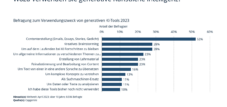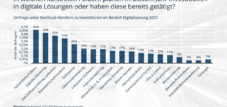When is it worthwhile for plant and mechanical engineering to rely on artificial intelligence? Where is the benefit?
Language selection 📢
Published on: September 8, 2024 / update from: September 8, 2024 - Author: Konrad Wolfenstein

When is it worthwhile for plant and mechanical engineering to rely on artificial intelligence? Where is the benefit? – Image: Xoert.Digital
💡📈 Optimization through AI: Potential in plant and mechanical engineering
🚀💻 AI as a key technology in mechanical engineering: costs and benefits
Artificial intelligence (AI) has established itself as a key technology in many industries, and plant and mechanical engineering has not remained unaffected by this development. While digitalization has long played a major role in industry, AI opens up new opportunities to optimize processes, reduce costs and drive innovation. But when exactly is it worthwhile for companies in plant and mechanical engineering to rely on AI? And where is the point at which the efficiency gains exceed the investment costs – the so-called break-even point?
The following will examine in which areas AI can be used in mechanical engineering, which factors influence the break-even point and how companies can ensure that they fully exploit the potential of this technology.
⚙️ AI in mechanical engineering: areas of application and potential
In plant and mechanical engineering, AI offers a variety of possible uses that can have a positive impact on the efficiency and competitiveness of companies. The most important areas of application include:
1. Predictive Maintenance
One of the greatest potentials of AI in mechanical engineering lies in predictive maintenance. By analyzing sensor data and operating parameters, AI-supported systems can detect and predict possible machine malfunctions or failures at an early stage. This prevents unplanned downtime and significantly reduces maintenance costs. A machine manufacturer can use predictive maintenance to ensure that expensive failures are minimized, increasing profitability in the long term.
2. Process optimization
In manufacturing, AI enables the continuous monitoring and optimization of production processes. By analyzing large amounts of data in real time, bottlenecks can be identified and processes can be adjusted immediately. This leads to an increase in productivity, a reduction in waste and an improvement in product quality. A good example would be automobile production, where AI optimizes production lines and responds flexibly to changes in demand through machine learning.
3. Quality control
AI is also playing an increasingly important role in quality testing. Using machine vision and advanced image processing, AI systems can detect defects and deviations in manufactured parts more accurately and quickly than traditional inspection methods. This reduces the reject rate and increases the efficiency of quality control.
4. Robotics and automation
The use of AI-controlled robots and automation solutions is increasing in mechanical engineering. AI enables robots to complete tasks autonomously and more flexibly than is possible with conventional programs. This creates an enormous advantage, especially in manufacturing and logistics.
5. Product design and development
AI can also assist in the product development process by running simulations, making complex calculations and making suggestions to optimize designs. By using generative design, in which AI suggests new design options based on defined parameters, completely new and more efficient solutions can be created.
💼 When is it worth investing in AI in mechanical engineering?
The benefits of AI depend on various factors that companies in plant and mechanical engineering must carefully consider before deciding to invest in this technology.
1. Company size and resources
Larger companies with comprehensive production processes and large amounts of data can benefit more quickly from the advantages of AI. The reason for this is that the efficiency gains through AI are particularly high in extensive and complex processes. Small and medium-sized companies (SMEs), on the other hand, should first check whether their production processes are sufficiently standardized and whether there is enough data available to use AI profitably.
2. Existing database
AI relies heavily on data. Companies that have already built a solid data infrastructure and continuously collect data are better able to implement AI applications quickly and efficiently. Companies that are still at the beginning of their data strategy must first invest in data management and preparation before they can benefit from AI applications.
3. Complexity of processes
Companies with highly complex manufacturing processes where there are many variables can particularly benefit from the optimization potential of AI. AI systems are able to process large amounts of process data in real time and thus identify bottlenecks or inefficiencies. For standardized or less complex processes, the need and benefit of AI may be less.
4. Cost and ROI
Implementing AI initially requires large investments – both in technology and in employee training. Companies need to ensure that the costs can be offset by the savings and efficiency gains. A clear cost-benefit plan and phased implementation help reach the break-even point.
📈 The break-even point: When does AI become profitable?
The break-even point is the point at which the savings and revenue gains from using AI exceed the initial investments. This point depends on several factors:
Investment costs
The initial investments in AI systems, hardware and software as well as employee training are crucial for calculating the break-even point. Companies should not only consider the direct costs of AI technology, but also possible indirect costs, such as adapting the existing IT infrastructure or implementing security measures.
Savings potential
How high are the expected savings from automating and optimizing processes? Companies need to carry out a detailed analysis in advance to determine in which areas AI will bring the greatest benefit. As a rule, companies in production and operations have great savings potential through AI, as costs can be significantly reduced through automation and predictive maintenance.
Market requirements and scalability
Companies that operate in a dynamic market environment and need to quickly scale their production can gain a significant competitive advantage through the use of AI. Scalability is a crucial factor here, as AI systems are able to react flexibly to changes in demand and quickly adapt processes.
📊 How companies can reach the break-even point faster
To reach the break-even point faster and make AI investments profitable, there are several approaches companies can take:
1. Gradual implementation
Instead of starting large AI projects all at once, companies should proceed gradually. Pilot projects in individual departments or for specific processes make it possible to gain initial experience and better understand the technology. This reduces risk and helps reach the break-even point faster.
2. Optimize use of existing data
Since AI is based on data, it is crucial to optimize the data infrastructure. Companies should ensure that their data is well organized and accessible to AI systems. Data management systems and cloud technologies can provide support here.
3. Collaborate with AI experts
The lack of skilled workers can delay the implementation of AI. Companies should therefore implement their projects in collaboration with external consultants or research institutions. This saves time and money and leads to success more quickly.
4. Long-term planning
AI is a technology that should be implemented in the long term. A clear strategy, regular performance reviews and the continuous adaptation of AI applications are crucial to reaching the break-even point and being profitable in the long term.
🏆 When is AI worthwhile in mechanical engineering?
AI is worthwhile for companies in plant and mechanical engineering if the requirements in terms of data, processes and resources are met. The technology offers enormous potential for increasing efficiency, especially in predictive maintenance, process optimization and quality control. The break-even point depends on the investment costs and the savings potential and can be achieved more quickly through gradual implementation and targeted optimization measures.
For companies that carefully plan and implement the necessary steps to introduce AI, the technology can be a decisive competitive advantage. However, it is important that each company individually considers when and to what extent it makes sense to rely on AI.
📣 Similar topics
- 🤖 Increased efficiency through AI in mechanical engineering
- 🛠️ Predictive Maintenance: Future of machine maintenance
- 📊 Process optimization through AI: An overview
- 🔍 AI-powered quality control: precision and speed
- 🚀 Automation in mechanical engineering: Advantages of AI-controlled robotics
- 💡 Product design with AI: promote innovation
- 📈 When is it worth investing in AI in mechanical engineering?
- 💰 Cost-benefit analysis of AI implementations
- 📉 Break-even point: When does AI become profitable?
- 🏭 Optimal use of existing data for AI projects
#️⃣ Hashtags: #ArtificialIntelligence #Mechanical Engineering #ProcessOptimization #PredictiveMaintenance #Automation
We are there for you - advice - planning - implementation - project management
☑️ SME support in strategy, consulting, planning and implementation
☑️ Creation or realignment of the digital strategy and digitalization
☑️ Expansion and optimization of international sales processes
☑️ Global & Digital B2B trading platforms
☑️ Pioneer Business Development
I would be happy to serve as your personal advisor.
You can contact me by filling out the contact form below or simply call me on +49 89 89 674 804 (Munich) .
I'm looking forward to our joint project.
Xpert.Digital - Konrad Wolfenstein
Xpert.Digital is a hub for industry with a focus on digitalization, mechanical engineering, logistics/intralogistics and photovoltaics.
With our 360° business development solution, we support well-known companies from new business to after sales.
Market intelligence, smarketing, marketing automation, content development, PR, mail campaigns, personalized social media and lead nurturing are part of our digital tools.
You can find out more at: www.xpert.digital - www.xpert.solar - www.xpert.plus























